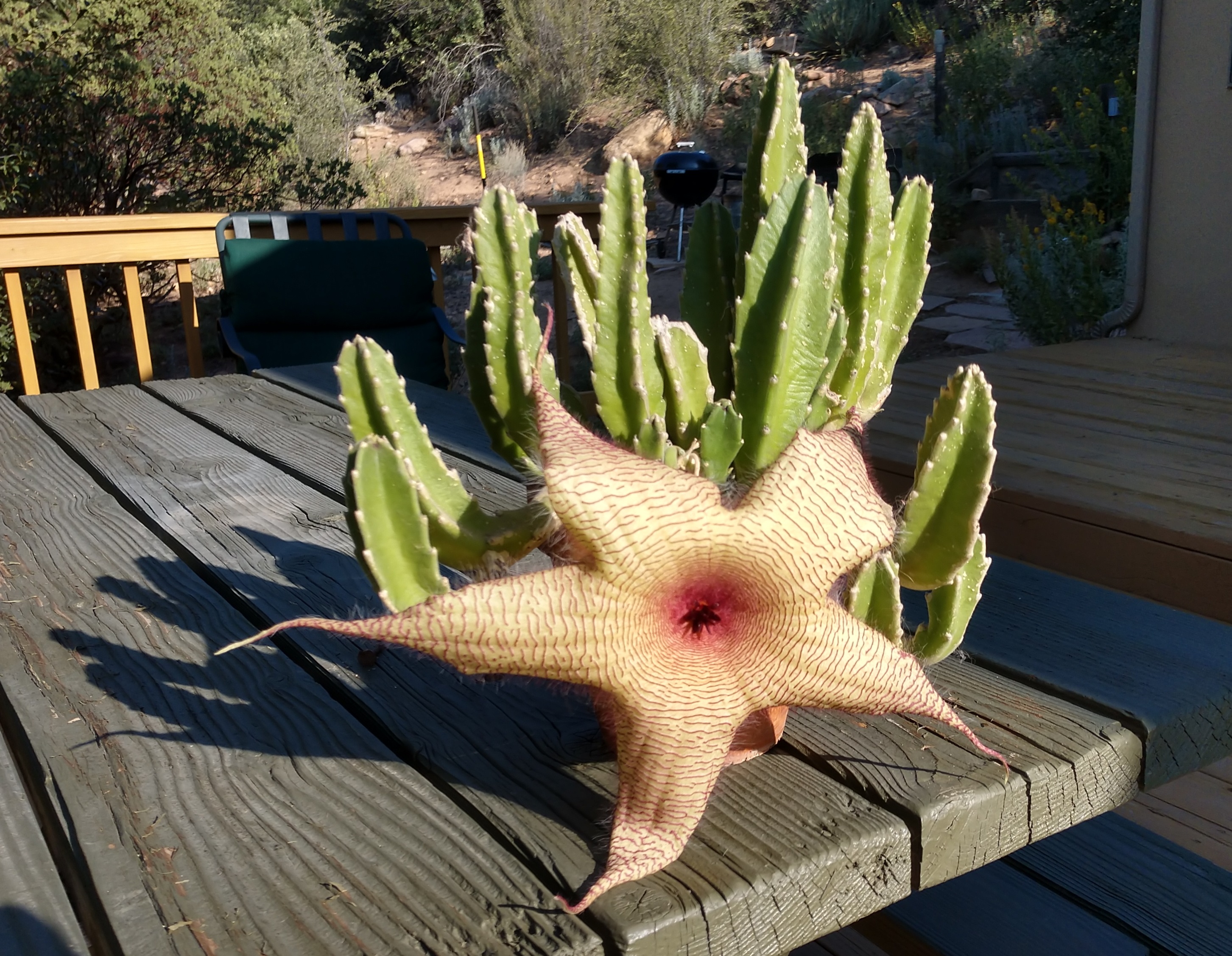 Did Something Die or is the Stapelia Blooming? - September 18, 2019 Jeff Schalau, Agent, Agriculture & Natural Resources University of Arizona Cooperative Extension, Yavapai County Stapelia is a genus of perennial succulent plants from South Africa. It is in the Dogbane Family (Apocynaceae) which is the same plant family as milkweeds. Many species of Stapelia are known for having flowers that smell like rotting meat giving them the common name “carrion flower”. A less repellent common name is “starfish flower”. I’ve had one of these plants for 20 or more years and it has never required special care. South Africa is home to many species of succulents and is similar in precipitation and summer temperatures to the southwest deserts of the U.S. However, the maritime influence in South Africa tends to buffer the extreme cold temperatures making the succulents from there more frost tender. Higher elevations of the Mohave, Chihuahuan, and Great Basin deserts can be very cold and regularly experience freezing temperatures. This difference often requires South African succulents to be grown in frost-free areas or as indoor plants for at least a portion of the year. Many of South African succulents also look similar to New World cacti and succulents, but upon closer examination, they are quite different. Some have spines, causing them to appear similar to cacti. Others form rosettes similar to Yucca and Agave. It is quite interesting these plants independently evolved similar characteristics even though they are found on opposite ends og the planet. South African succulent genera readers may be familiar with are: Sedum, Aloe, Euphorbia, Crassula, and Kalanchoe. My carrion flower is Stapelia gigantea. This species only grows about 8-10 inches tall and has smooth, erect, light green stems. The large star-shaped, five-petalled, flowers appear on the lower portion of the short plant in late summer and are about 10 inches in diameter. The flowers of S. gigantea are yellow with narrow red stripes arranged radially around the petals. The flowers are also fringed with 1/3-inch-long hairs. The flower is said to smell like rotting meat to attract the flies that pollinate it. Interestingly, I can’t detect a foul smell on the flowers of my Stapelia and I think I have a keen sense of smell. Many Stapelia species are available for purchase from succulent nurseries. One reference I found listed 55 species of Stapelia, but only a small number of these are readily available for purchase. I found S. hirsuta, S. leendertziae, S. lepida, S. schinzii, and S. gigantea offered for sale from online sources. There are also Stapelia relatives in the genera Edithcolea, Stapelianthus, Caralluma, and Huernia. In the higher elevations of Arizona, Stapelia should be grown in a small or medium-sized unglazed, clay pot with a large drainage hole. This pot should easily moveable avoid freezing temperatures. I keep mine indoors year round in a bright, sunny location. The potting mix should be appropriate for succulents and cactus. This can be mixed at home using two parts washed sand and one part mineral soil (weed free soil from outdoors). Plant rooted cuttings into the soil mix and water until water drains from the hole in the pot. Use care not to overwater Stapelia as it can cause root rot. Stem cuttings and seed can be used to propagate Stapelia. Most home gardeners will propagate it from cuttings (see the link with the online edition for growing from seed). Cuttings should be taken during the active growth phase (summer) and prior to dormancy. Allow the cutting to dry out in a shady location for two weeks before planting. Place cuttings in the soil mixture and keep in a well-ventilated area with about 40% shade. Allow soil to dry between watering. References list stem rot and wooly aphids as pests. These may be more of a concern within Stapelia’s native range as I have not encountered any pest problems with my plant nor have I run into others that have had these problems. Some references mention fertilizing Stapelia. I would do so infrequently (two light fertilizations during the growing season). Stapelia is not for everyone, but I think many gardeners would like this plant for its uniqueness and ease of care. If the smell becomes too much, simply move the plant outside during the flowering cycle. I have included additional resources with the online edition (see URL below). Watch for pollinators during flowering – you may even attract an errant turkey vulture! You can follow the Backyard Gardener on Twitter – use the link on the BYG website. If you have other gardening questions, call or email the Master Gardener help line in the Prescott (928-445-6590/prescottmg@gmail.com) or Camp Verde (928-554-8992/verdevalleymg@gmail.com) and be sure to include your name, address and phone number. Find past Backyard Gardener columns or provide feedback at the Backyard Gardener web site: http://cals.arizona.edu/yavapai/anr/hort/byg/. Photo  Carrion flower in bloom (Stapelia gigantea, Jeff Schalau, University of Arizona).
Carrion flower in bloom (Stapelia gigantea, Jeff Schalau, University of Arizona).Additional Resources Stapelia, South Aftican National Biodiversity Institute pza.sanbi.org/stapelia Stapelia gigantea, Wikipedia en.wikipedia.org/wiki/Stapelia_gigantea |